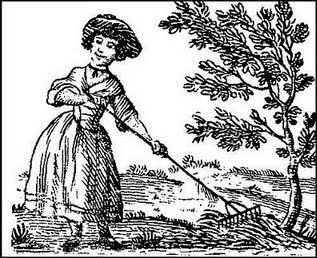|
The Breadcrumbs widget will appear here on the published site.
I Worked on a Southern PlantationBy Christine Stoddard QuailBellMagazine.com “Adjust your mobcap.” “Milk the cows.” “Harvest tobacco.” Up until very recently, I worked at one of Virginia's best-known plantation for a month. It was a part-time job I left when a full-time job offer came along. But during that short period, I raked up a lot of story fodder. When I went to work, I not only had to be on time—I had to go back in time. And I didn't even own a time machine. It was all about using my noggin and projecting the aura of bygone days. The morning began by waking up at 7:30 a.m., wolfing down breakfast, and hopping into the car. Then I hit Route 5, passing the thick of verdant cornfields and farmhouses fit for storybook illustrations. Civil War battlefield signs and other gray historical markers common in the Old Dominion lined the old highway. As I drew closer to the plantation, tall tree began to bow and lace their fingers high above my car, forming a shady canopy that only allowed the stubbornest of sun beams to dapple the pavement.
Finally I would spot the wooden sign before my plantation and turn right onto a long gravel driveway. At this point, I turned down the radio to listen to the chorus of birds perched in the paulownias. Once Led Zeppelin's “Stairway to Heaven” was on and it made for the perfect soundtrack. A much-needed summer breeze rustled the foliage on either side of me. In the distance, I saw the soy plants swaying back and forth under an azure sky. But this calm would not last for long. “So, how many bricks make up the manor house?” “Aren't you hot? What are you wearing under that dress? Petticoats?” “Where's the bathroom again?” My job was to run the gift shop, schedule tours, and shadow seasoned tour guides so I could one day soon give tours myself. All the while, I had to answer a range of questions about Colonial America (and sometimes about my underwear). Customers came from across the United States, as far away as Seattle, as well as from across the world. In a single day, I met folks from Germany, Denmark, Ontario, and every corner of the country. The gift shop lived in the plantation's old guest house, where the manor family would have visitors and travelers stay. Colonial Americans enjoyed guests far more often than modern Americans because transportation then was so much slower. Any hour of the day, I can get from my house in Richmond to Williamsburg in an hour. By comparison, that same trip would've taken Colonial Americans literally days by carriage or river boat. Once your friends or cousins arrived at your house, chances are they planned to stay awhile. Back then, there were slaves whose main job was to wait on guests hand and foot. The guest house, once solid brick, had been covered over with stucco the color of Virginia clay during its 1920s renovation. Otherwise, the house resembles its Colonial self, with shutters and hardwood floors like a good example of Georgian architecture. That was where I spent most of my working day, dressed in typical Tidewater cotton. Though there were never slow days, there were occasionally slow periods and during those lulls, I was fortunate enough to be surrounded by history books and unusual trinkets like finger vases. The job taught me a lot about American history (e.g., did you know the first Thanksgiving actually took place in Virginia?) and customer service (never assume someone qualifies for or even wants a senior discount), while reinforcing my love for storytelling and the human condition. No matter the era, people were and are people. Even if they wore powdered wigs and only bathed once a year. CommentsComments are closed.
|
|








